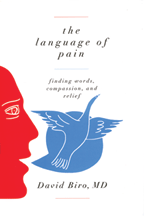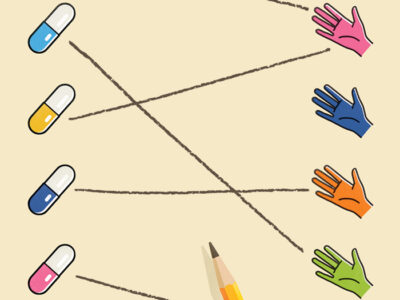A physician who has looked at pain from both sides examines the language we use to describe it.

THE LANGUAGE OF PAIN:
Finding Words, Compassion, and Relief
By David Biro C’86
W.W. Norton & Co.,
2010. $24.95.
By Kayla Rosen | “It feels like an elephant sat down on my chest.” “Like a ball of flames charring my stomach lining.” “Like a rat gnawing at my skin.” These are a few patients’ responses to the same question: “Can you describe the pain?”
It is a notoriously difficult question to answer. The challenge of describing a sensation as internal, as elusive, as pain often stretches our capacity to communicate plainly and demands that we use figurative speech. These lyrical descriptions may point toward a specific diagnosis. An elephant sitting on one’s chest, for example, suggests a heart attack more than does a poker stabbing one between the ribs.
But it’s about more than diagnostics. A patient’s ability to precisely describe pain enables a physician to understand the experience and to provide better support and care. For a person in pain, this is invaluable.
In his insightful book, The Language of Pain, David Biro C’86, an associate professor of dermatology at SUNY Downstate Medical Center in Brooklyn, argues for the vital importance of describing pain. For most patients in pain, he writes, “language runs dry.” For every patient who speaks of the “elephant” or the “flames,” there are five others for whom “it just hurts.” In this vein, he cites Hannah Arendt: “The most intense feeling we know of … the experience of great pain, is at the same time the most private and least communicable of all.”
Biro knows about this dire communication deficit from a personal encounter. In some of the book’s most affecting passages, he describes his own experience switching roles from doctor to patient after enduring harrowing complications of a bone-marrow transplant. Biro’s observation that “when we are in pain, there’s nothing but the pain,” is spoken with the simple eloquence of experience. As a patient, Biro felt detached, isolated from his family and friends. With keen sensitivity, he describes how pain sweeps patients’ perspectives inward, making them “retract like mollusks.”
But he doesn’t merely chronicle the way pain leads to a “poverty of language” and lament the “consequences of silence.” He offers a solution. As a scholar of literature (Biro received his doctorate in English literature from the University of Oxford), he makes the case for the transcendent power of language. Words, he argues, allow us to emerge from the loneliness of pain.
In The Language of Pain, Biro aims to “generate a rhetoric of pain,” since language “can replace isolation with community.” Noting how “pain urges us to take extreme measures to respond and express ourselves,” he points out that when we are in pain, “we don’t choose metaphor but are forced in that direction because there is no literal language.” Metaphor is no longer the sole province of artists, Biro says; it is used by the man in the street as well as James Joyce.
Biro draws from a wide range of rhetoric, including poetry. He cites Emily Dickinson’s “Pain—has an Element of Blank—” as an example of verse that highlights the sensation’s formlessness. Pain pulls one out of time, making it hard to think of the future or the past, or to imagine an end to the anguish. But Dickinson places the word Blankwithin a defined poetic form, thus lending “Pain” a shape. “While pain has no structure,” he concludes, “metaphors of pain” do.
The utility, and immense challenge, of creating a structure for pain is familiar to any health-care provider. In my own experience working with women in labor, I found that in spite of the regularity and finite nature of contractions, time seemed to stop for many women in the midst of such jolting pain. With one patient I watched the tracing of the contraction monitor—which, like Dickinson’s poetic form, gave literal shape to her pain. By simply reporting to her each time she passed over the hump of a contraction, I invited her to “see” the pain concretely, to speak of it as a recurring shape, and thus to anticipate it in exactly the way a rhyme might be predictable in a sonnet. It helped her tolerate the suffering.
Such moments of pain, Biro suggests provocatively, provide a unique opportunity to incite in us a reawakening of language.
“By forging novel ways to think and speak through metaphor, we ordinary people become creators,” he says. Language, through the act of voicing one’s pain and therefore finding a way to conceptualize its elusiveness, “becomes truly therapeutic—a form of medicine that has the power to relieve our suffering.”
Biro devotes a great deal of the book to close readings of literary and philosophical texts and to analyzing the mechanics of metaphor. (He also mentions the stories of actual patients, though to a lesser extent.) His emphasis on literary texts is both pragmatic—in that writers provide us “the luxury of seeing from multiple perspectives in a less hectic time frame”—and also aesthetic. Literature can “elaborate and stretch the metaphor in ways that may enhance our understanding of pain’s aversiveness.”
He divides the lengthy section on metaphor into three parts, each one delving into a different “metaphorical strategy.” In the first, “the weapon,” Biro analyzes the mechanics and utility of the most common pain metaphor, that of an agent moving toward the body. He points to Jack London’s description of the pain caused by a fierce wind, imagined as an air current composed of millions of particles of sand, and notes London’s tactic of using metaphor to legitimize the pain by making the (invisible) wind’s force visible and tangible—a large force composed of an infinity of tiny points of contact. In the second section, “the mirror,” Biro describes projection metaphors that enable the sufferer to imagine “objects onto which he can project his feelings and desires.”
The final section, “the x-ray,” is devoted to examining anatomic metaphors that allow patients to “create images of the inside of the body with words.” When Biro underwent his transplant and the lining of his gastrointestinal tract began to slough, leaving him “with a string of ulcers from the mouth to the anus,” he says he found himself picturing a “forest fire sweeping down the long convoluted piping network” of his digestive tract.
Biro presents an overwhelming number of sources in these sections, from Leo Tolstoy to Frida Kahlo to Ludwig Wittgenstein, and the book is weighed down by the heft of these readings. Biro’s most profound insights, drawn with succinct beauty in the introduction and postscript, are blunted by the excessive number and length of close-reads.
That’s a shame, because Biro treats language with refreshing seriousness. In spite of the theoretical nature of his arguments, he aims to impart practical advice. He believes that language can literally transform the way we handle pain as individuals and as a community, and his book encourages patients to work harder at expressing themselves and challenges physicians to ask better questions.
“Should we start speaking like [Jack] London and Tolstoy in front of our doctors?” he asks. “Yes … If we want to communicate effectively,we must rely on the same strategies employed by our best writers.”
For physicians and patients, and their families, healing begins in the robust use of words.
Kayla Rosen, a fourth-year medical student at Penn, received the William Carlos Williams Poetry Prize for best original poems by a graduate student.




